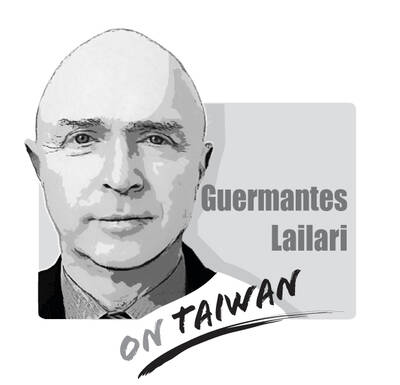It is always encouraging to see members of the international community pay attention to Taiwan, whose travails as it navigates the rough seas of its relations with China are often conveniently ignored for the sake of “larger” considerations.
Given the potential ramifications of tomorrow’s presidential elections for regional security and Taipei’s relations with Beijing, it is unsurprising that an army of foreign reporters and academics would be parachuted into Taiwan to observe its rambunctious democracy at work.
Equally welcome is the arrival of international observers who have been invited by local organizations to monitor the elections to ensure that the process is fair and does justice to the sacrifices made by previous generations of Taiwanese who, for decades, did not have the privilege of selecting their leader.
In a highly charged campaign marked by scandals — from the possible falsification of evidence used in allegations against Democratic Progressive Party (DPP) presidential candidate Tsai Ing-wen (蔡英文) to claims that intelligence agencies engaged in illegal surveillance against her — the presence of neutral electoral monitors from abroad could provide a much-needed dose of sobriety to the whole affair. Or it should have.
The problem is that the organizations behind the invitations extended to the international monitors have at times appeared more interested in underscoring which candidate they hope will win rather than making sure that the electoral process remains transparent and is not tampered with.
One could argue that such an outcome was inevitable, a consequence of the vast resource disparity that exists between the two principal political parties involved in the elections. Despite claims to the contrary, President Ma Ying-jeou’s (馬英九) Chinese Nationalist Party (KMT) remains one of the wealthiest political entities in the world, turning Tsai into a bit of a David against the KMT Goliath, an imbalance that has only been exacerbated by the overt support given the KMT by Beijing, big business, institutional investors and even some elements within the White House.
As a result, whether it was intended or not, the International Committee for Fair Elections in Taiwan (ICFET), which counts the likes of DPP legislator Chai Trong-rong (蔡同榮) as its executive chairman, has come across as pretty green.
Not to be bested, the pan-blue side recently announced that it had invited its own international monitors, a group that includes former American Institute in Taiwan director Douglas Paal.
Anyone who accuses the minds behind the ICFET of being too green and therefore partial should look at the political affiliations of the Cross-Strait Interflow Prospect Foundation, the think tank that invited Paal and others to come to Taiwan to observe the elections. Its chairman, Louis Tzen (鄭文華), is closely affiliated with the KMT’s in-house think tank, the National Policy Foundation.
Unfortunately for the majority of international monitors who did come to Taiwan as impartial observers, the politicization of the groups risks undermining their credibility. This, in turn, could make it more difficult for their findings to be taken seriously and could give rise to accusations that they are taking sides in the election — especially if serious irregularities were to be uncovered by the observer groups.
Whether they knew it or not, international observers have been sucked into the vortex of green-blue politics in Taiwan. Through no fault of theirs, they arrive here facing a credibility handicap, victims of a political system whose impartiality is oftentimes observed in the breach.

Chinese state-owned companies COSCO Shipping Corporation and China Merchants have a 30 percent stake in Kaohsiung Port’s Kao Ming Container Terminal (Terminal No. 6) and COSCO leases Berths 65 and 66. It is extremely dangerous to allow Chinese companies or state-owned companies to operate critical infrastructure. Deterrence theorists are familiar with the concepts of deterrence “by punishment” and “by denial.” Deterrence by punishment threatens an aggressor with prohibitive costs (like retaliation or sanctions) that outweigh the benefits of their action, while deterrence by denial aims to make an attack so difficult that it becomes pointless. Elbridge Colby, currently serving as the Under
The Ministry of the Interior on Thursday last week said it ordered Internet service providers to block access to Chinese social media platform Xiaohongshu (小紅書, also known as RedNote in English) for a year, citing security risks and more than 1,700 alleged fraud cases on the platform since last year. The order took effect immediately, abruptly affecting more than 3 million users in Taiwan, and sparked discussions among politicians, online influencers and the public. The platform is often described as China’s version of Instagram or Pinterest, combining visual social media with e-commerce, and its users are predominantly young urban women,
Most Hong Kongers ignored the elections for its Legislative Council (LegCo) in 2021 and did so once again on Sunday. Unlike in 2021, moderate democrats who pledged their allegiance to Beijing were absent from the ballots this year. The electoral system overhaul is apparent revenge by Beijing for the democracy movement. On Sunday, the Hong Kong “patriots-only” election of the LegCo had a record-low turnout in the five geographical constituencies, with only 1.3 million people casting their ballots on the only seats that most Hong Kongers are eligible to vote for. Blank and invalid votes were up 50 percent from the previous
Alarm bells over a “hollowing out” of Taiwan’s semiconductor industry and US demands for “protection money” have fueled a panic over Taiwan. To understand how misplaced these fears are, consider the movements of global technology giants. Nvidia Corp CEO Jensen Huang (黃仁勳), Advanced Micro Devices Inc (AMD) CEO Lisa Su (蘇姿丰) and Taiwan Semiconductor Manufacturing Co (TSMC) chairman C.C. Wei (魏哲家) could undoubtedly understand the situation best, and they continue to make key investments in Taiwan. They do not make decisions on a whim. They are the architects of global computing power strategy and possess the highest levels of industry knowledge. No